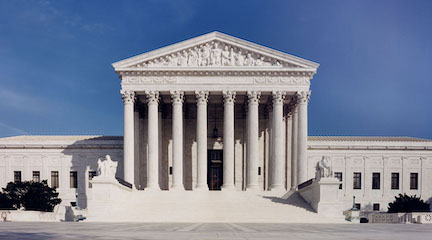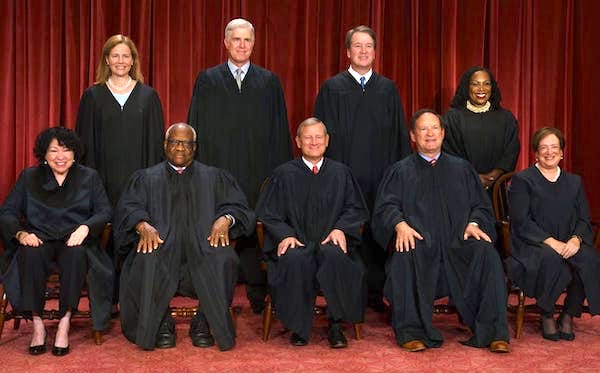 |
A Vacancy on the Court | < |
The JusticesAs of 2022 there have been 121 appointments to the Court, counting the interim appointment of John Rutledge in 1795, an appointment ultimately rejected by the Senate. Katanji Jackson is only the 116th person to be appointed, however. Five justices have filled positions twice, 3 elevated from Associate Justice to Chief Justice (E. White, H. F. Stone, and W. H. Rehnquist), Charles Evans Hughes who was reappointed to the Court after having resigned once before, and Rutledge who actually served as Chief Justice during a term before his rejection by the Senate. Click on the link "List of All Justices" to see a list of all 116, along with with information about them and their appointments. Justices' Voting PatternsThe Court is often characterized as a battleground between conservative and liberal ideologies. There is more to that than the justices wish to recognize and less to it than advocacy groups argue. Limiting political ideology to conservative v. liberal establishes a false dichotomy. Other ideological perspectives exist, perhaps most prominently in the American context, libertarian and communitarian to mention only two. To further complicate any ideological analysis, the multidimensionality of issues appearing in any one case may find justices in agreement on the judgment rendered while differing on the rationales for that judgment. It is also true that a number of issues arising before the Court simply defy ideological description. Finally, justices are constrained by the texts of the Constitution, laws, treaties, etc. and, regardless of ideology and personal beliefs, justices do restrain their ideological predilections, some more than others, but all to some extent. The fact that unanimous decisions are typically rendered in a third of the cases accepted and addressed by the Court testifies to a common acceptance of certain constraints and common understandings. For the 2021/22 term of the Court, 22 of the 66 cases (33%) were decided unanimously. With those caveats in mind, it remains patently clear that justices do differ along lines that permit ideological interpretations. That Justices Alito and Sotomayor agreed with each other in only 2 of the 34 cases with a 7-2 or greater split and none of those involving a competing conservative/liberal position suggests some fundamental differences between the two. Ideological distinctions seem easiest to apply in areas involving the Bill of Rights and certain due process issues, especially those parts where individual rights, a libertarian principle, and equal protection, a liberal principle, may collide. Conservatism developed originally as a reaction to classical liberalism and in this constitutional context, a conservative position would favor limiting individual rights that challenge or disturb prevalent societal norms and customs while limiting efforts to mandate equality. Because the libertarian position can sometimes be assumed by liberals (individual liberty v. state imposition of societal norms) and other times by conservatives (individual liberty v. state mandated equality), it is easier to contrast positions as being liberal or conservative because they never coincide. Consequently, we may define outcomes of certain cases as being more consistent with either conservative or liberal positions recognizing that a libertarian position, or for that matter a communitarian one, could coincide with the conservative or liberal position, depending on the issue. For the perils in trying to classify cases as having conservative or liberal outcomes, view this pop-up on the Davis v. Washington (2005) and Hammon v. Indiana (2005) cases. Ideology and Voting OutcomesThe replacement of Justice O'Connor with Samuel Alito by President Bush in 2006 established a more solid conservative bloc of five justices. For the 2006/07 term, nearly three fourths of 30 conservative/liberal cases resulted in outcomes more conservative than liberal, new justices Alito and Roberts joining up with Scalia, Thomas, and Kennedy. For the thirty conservative/liberal cases in that term, nearly three-fourth (22) were decided in a direction that could be defined as more conservative than liberal. But Justice Kennedy was not a conservative stalwart. In the 2011/12 term, his as a swing vote was clear. He was in the majority in 12 of the 13 5-4 cases, as well as in all of the other 12 ideological cases that were not decided in 5-4 splits. He sided with the liberal quartet of Sotomayor, Ginsburg, Breyer, and Kagan in 11 cases and with the conservative quartet of Thomas, Scalia, Alito, and Roberts in 14 cases. In his final term of 2017/18, however, he voted with the conservative position in every 5-4 case, even though Roberts did not in two of them and Gorsuch in another one. The replacement of Anothony Kennedy with Brett Kavanaugh and Ruth Ginsburg with Amy Barrett has solidified the conservative perspective of the Supreme Court. A pop-up table provided here for the 2021-22 term displays the voting blocs quite clearly. In 20 of 66 cases decided by a 5-4 or 6-3 vote that lend themselves to identifiable conservative-liberal positions, Justices Alito, Thomas, and Barrett voted in the conservative direction on all 20 cases. Gorsuch was right there as well in 18 of the 20 while Kavanaugh and Roberts joined the conservatives in 15 of the 20. Of the liberal bloc of three, Sotomayor voted in the liberal direction all 20 times, Kagan 19, and Breyer 18. Only 2 of the 20 cases favored the liberal position, involving Biden administration actions regarding vaccination and immigration policies, respectively. The 2022 replacemet of Justice Breyer with Justice Jackson is anticipated to keep the liberal a solid threesomeLast update: October 25, 2022 by GW |